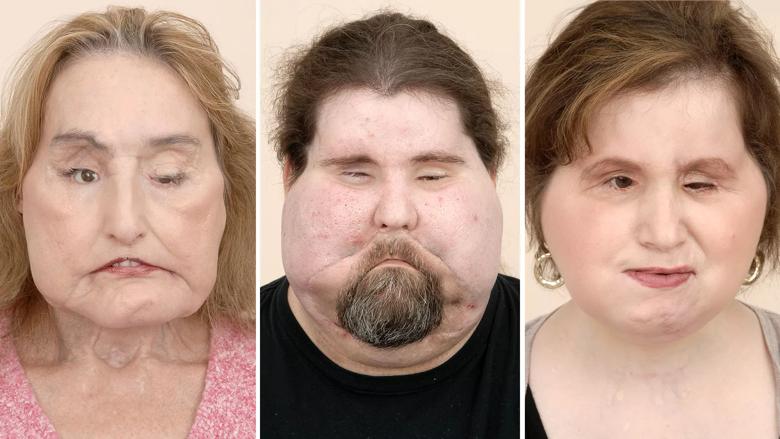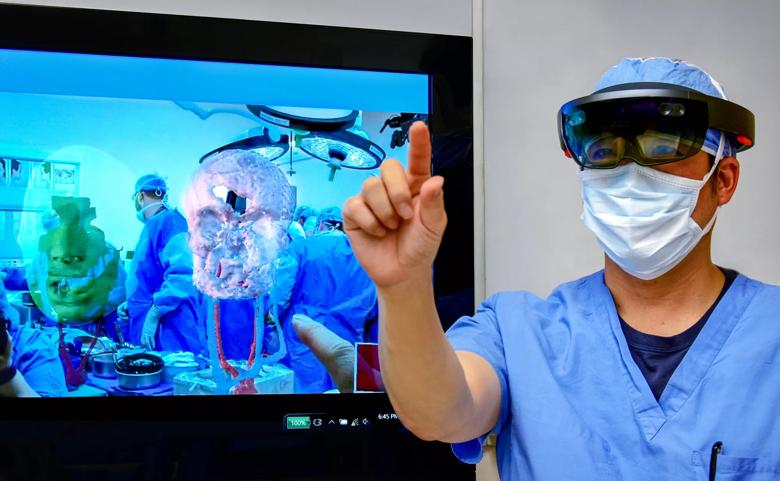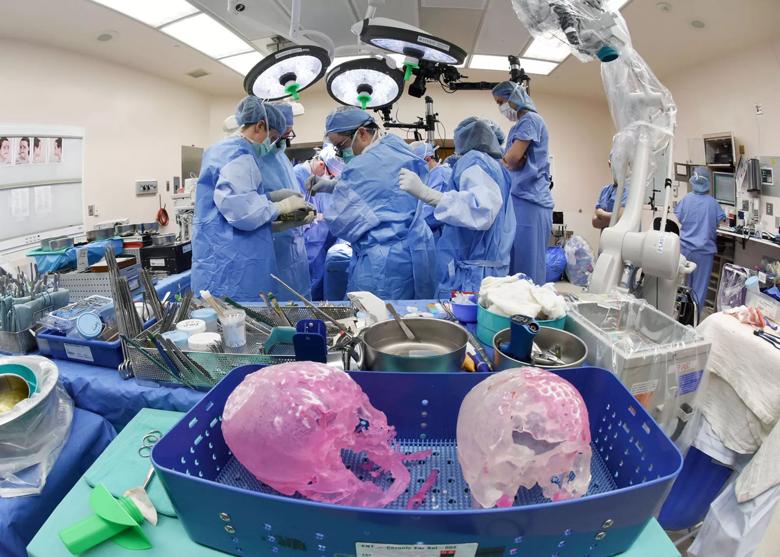Cleveland Clinic News Service | 216.444.0141
We’re available to shoot custom interviews & b-roll for media outlets upon request.
CCNS health and medical content is consumer-friendly, professional broadcast quality (available in HD), and available to media outlets each day.

To many, the human face defines personhood. When it is devastated beyond the reach of conventional plastic or restorative surgery, a patient may lament both the loss of their appearance and simple functional abilities such as smiling, talking, eating, or breathing on their own.
In these rare instances, a face transplant may be the only solution that can sufficiently restore the patient’s quality of life and function.
A face transplant is an intricately complicated, personalized medical procedure that replaces as much as 100 percent of the recipient’s facial tissue with that of a deceased donor. The surgery can integrate many different functional components, such as nose and lower eyelids as well as different tissue types including, skin, muscles, bony structures, arteries veins and nerves.

As of August 2018, around 40 face transplants have been performed worldwide. In 2008, Cleveland Clinic became the first hospital in the United States to perform a near-total face transplant, and remains one of just six U.S. institutions to have conducted the surgical procedure.
Cleveland Clinic doctors performed the initial 22-hour procedure on a 40-year-old woman who suffered severe facial injuries from a gunshot to the face. A Cleveland Clinic surgical team integrated functional facial components and numerous tissue types, including skin, muscles, bony structures, arteries, veins and nerves – encompassing about 77 square inches of transplanted tissue.
Prior to undergoing her face transplant, the patient wasn’t able to eat solid foods, drink from a cup, or breathe through her nose. She decided to undergo the transformative surgery after dozens of other procedures failed to restore her form and function.
The second Cleveland Clinic face transplant occurred in 2014, a 24.5-hour surgery on a middle-aged man who suffered severe facial trauma and other complications from a motorcycle accident. In this instance, nine surgeons and numerous specialists transplanted about two-thirds of the scalp and replaced about 90 percent of the patient’s face.
Previously, the patient underwent multiple reconstructive surgeries to improve facial form and function. But he was still missing the middle portion of his face and forehead, had limited function in one eye, and had difficulty breathing and speaking. Thus, he was willing to assume the risk associated with a face transplant as his only remaining option to restore some degree of normalcy to his life.
“Can you live without a face?” Frank Papay, M.D., chairman of the Dermatology & Plastic Surgery Institute at Cleveland Clinic, asked rhetorically at the time. “Yes. But it’s very difficult, and not a good quality of life. Having a face to face the world is probably one of the more important functions we have as human beings communicating with each other.”
Most recently, in 2017, a team of 11 Cleveland Clinic surgeons and multiple specialists performed the hospital’s third face transplant – and its first total face transplant – on 21-year-old Katie Stubblefield, a woman who suffered severe facial trauma and other complications from a gunshot wound as a teenager.
RELATED: Road to Recovery: Woman is Youngest Patient in United States to Receive Face Transplant
She is the youngest patient in the U.S. to receive a face transplant. Youth can be an advantage for a successful transplant because the patient is typically more robust, and potentially has many more years to benefit from the surgical transformation.
At 21, Katie is the youngest person in the U.S. to receive a face transplant.
A year later, she’s on the road to recovery. https://t.co/inoTzARcDP pic.twitter.com/N5qkNtltR1
— ClevelandClinicNews (@CleClinicNews) August 15, 2018
Due to the extent of the woman’s injuries, the painstakingly planned and orchestrated procedure was one of the most extensive ever attempted. It involved transplantation of the scalp, forehead, upper and lower eyelids, eye sockets, nose, upper cheeks, upper jaw and half of the lower jaw, upper teeth, lower teeth, partial facial nerves, facial muscles, and skin — effectively replacing 100 percent of her facial tissue.
And a landmark aspect of the 31-hour procedure was the use of techniques and technologies – such as surgical rehearsal, 3D printing and virtual reality – as the main platforms for preoperative planning.
These pioneering platforms – not yet invented or honed during the previous transplants — helped optimize the accuracy, aesthetic and functional outcomes.
According to Brian Gastman, M.D., a plastic surgeon and otolaryngologist, the Cleveland Clinic’s multidisciplinary face transplant team is highly collaborative, and continually seeks to learn from previous procedures and innovations to improve on its process – and patient results.
“I think our team approach is somewhat different than at other institutions. It’s much bigger, both surgically and non-surgically, with multiple redundancies built into our process,” Dr. Gastman noted. “We try not to be highly dependent on just one or two people.”
RELATED: How Augmented Reality Shaped Cleveland Clinic’s Total Face Transplant
One of the most transformative innovations used successfully during the 2017 procedure was HoloLens, the first self-contained mixed-reality computer headset that allows users to see holograms amid their surroundings. According to Dr. Papay, the HoloLens was useful in practicing various aspects of the surgery – over and over and over again – before actually performing it on the patient.

“Our biomedical engineers were able to create a virtual model of the patient’s face, where you can see everything – including the bone structure and blood vessels,” he said. “With the HoloLens on, you can virtually walk around and ‘see’ inside the patient’s face. It’s the next level of surgical modeling.”
An unconventional aspect of the Cleveland Clinic’s most recent procedure involved the use of 3D modeling to rebuild the patient’s jaw. Using a 3D computed tomography (CT) scan of the patient’s similar-looking sister, a 3D modeling company developed an intricate model of the patient’s jaw designed from the sister’s anatomy. Based on that, Dr. Gastman and team created and implanted a “new” jaw, using bone from the patient’s leg.

Further, ongoing advancements in the specialty areas associated with face transplants are also helping advance the field. In addition to plastic surgeons, the extensive team overseeing the complex procedure includes specialists in anesthesiology, bioethics, dentistry, ophthalmology, endocrinology, infectious disease, psychiatry, pharmacy and transplantation medicine.
While the technical aspects of face transplant surgery are now well-honed by the Cleveland Clinic team, an ongoing concern is one common to all forms of organ transplant: the possibility of rejection.
RELATED: National Geographic: How a Transplanted Face Transformed a Young Woman’s Life
As with any organ transplant, the patients are placed on lifelong immunosuppressive drugs. Thus, some members of the Cleveland Clinic team – including plastic surgeon Bahar Bassiri Gharb, M.D., Ph.D. – are conducting research into new ways to more accurately and noninvasively measure the body’s tolerance or intolerance of facial transplants. Such efforts to overcome the hurdle of requiring immune suppression, and the potential side effects of the medications needed to prevent rejection, will be another transformative milestone in the face transplant field.
It took years of preparation and dozens of medical personnel to perform Cleveland Clinic’s first total #facetransplant. https://t.co/NZ1EKuq0in pic.twitter.com/8qIampa8ml
— ClevelandClinicNews (@CleClinicNews) August 15, 2018
“A face transplant is a technical feat, but it’s now well accepted that it can be done,” explained Dr. Papay. “The key issue is: How do you prevent impending rejection? Are we going to eventually figure out ways to improve tissue tolerance? If we can solve that problem, it opens up a world of good for a lot of patients. That’s really the Holy Grail.”
Dr. Gastman and his colleagues are also hopeful the successful outcomes of the three Cleveland Clinic face transplants, and others throughout the U.S., will soon prompt Medicare/Medicaid and private insurers to cover the procedures. To date, most face transplants have been supported by the U.S. Department of Defense’s Armed Forces Institute of Regenerative Medicine I (AFIRM I) grant program, which is designed to help improve the treatment of U.S. service members wounded on the battlefield.
“This isn’t travel to the moon. It’s not something we do just to say we can make history, and then move on to something else,” Dr. Gastman exuded. “We know there are more people who will need it.”
Follow @CleClinicNews on Twitter for the latest stories on inspiring patients, medical innovation and breakthrough research.
Cleveland Clinic is a nonprofit multispecialty academic medical center that integrates clinical and hospital care with research and education. Located in Cleveland, Ohio, it was founded in 1921 by four renowned physicians with a vision of providing outstanding patient care based upon the principles of cooperation, compassion and innovation. Cleveland Clinic has pioneered many medical breakthroughs, including coronary artery bypass surgery and the first face transplant in the United States. Cleveland Clinic is consistently recognized in the U.S. and throughout the world for its expertise and care. Among Cleveland Clinic’s 82,600 employees worldwide are more than 5,786 salaried physicians and researchers, and 20,700 registered nurses and advanced practice providers, representing 140 medical specialties and subspecialties. Cleveland Clinic is a 6,728-bed health system that includes a 173-acre main campus near downtown Cleveland, 23 hospitals, 280 outpatient facilities, including locations in northeast Ohio; Florida; Las Vegas, Nevada; Toronto, Canada; Abu Dhabi, UAE; and London, England. In 2024, there were 15.7 million outpatient encounters, 333,000 hospital admissions and observations, and 320,000 surgeries and procedures throughout Cleveland Clinic’s health system. Patients came for treatment from every state and 112 countries. Visit us at clevelandclinic.org. Follow us at x.com/CleClinicNews. News and resources are available at newsroom.clevelandclinic.org.
Editor’s Note: Cleveland Clinic News Service is available to provide broadcast-quality interviews and B-roll upon request.